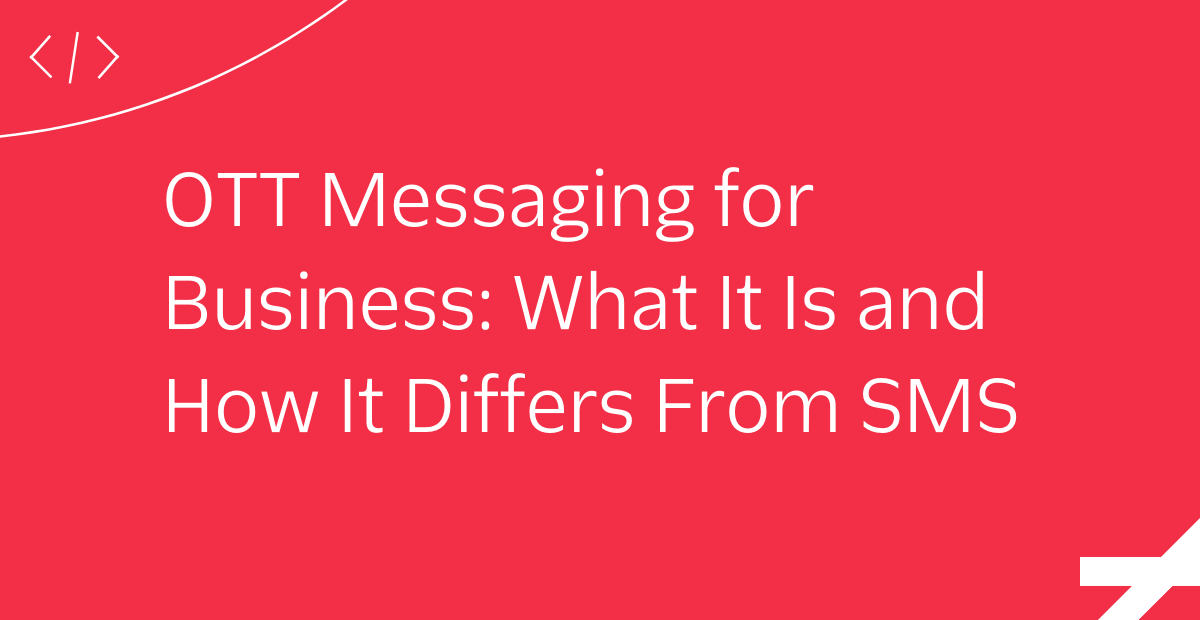OTT Messaging for Business: What It Is and How It Differs From SMS
Time to read: 3 minutes

Email and Short Message Service (SMS) are some of businesses’ preferred channels for connecting with customers. But a true omnichannel approach requires businesses to adopt additional channels, including over-the-top (OTT) messaging, to communicate with customers on their favorite platforms.
This post will cover what OTT messaging is, how it differs from SMS, its pros and cons, and how to get started with this communications channel.
What is OTT messaging?
OTT messaging is text-based communication on a platform that uses existing internet services to deliver messages. This includes instant messaging applications like Facebook Messenger, WhatsApp, Telegram, LINE, and WeChat.
In a broader context, OTT refers to technologies that layer over the top of existing delivery systems. For example, it can apply to media (e.g., Roku devices) and calling (e.g., Skype).
These types of applications are popular around the world due to the accessibility to anyone with a smartphone or tablet and an internet connection. OTT messaging platforms are not only great for connecting with family and friends but are also becoming an increasingly popular way to interact with businesses.
How does OTT differ from SMS?
For the user, sending an OTT message is no different from sending an SMS. However, there are a few key differences in how each channel operates.
Delivery
- SMS requires a mobile network for users to communicate, while OTT messaging services rely on the internet.
- SMS may require a fee to send and receive messages, depending on the user’s mobile plan, while OTT messages are free to send and receive as long as the user’s device is connected to the internet.
- SMS users need a phone number to send messages, while it can go either way with OTT messaging applications—some (like WhatsApp) require a phone number, and others (like Messenger) don’t.
User experience
- SMS is the default text message application preinstalled on mobile phones, while OTT messaging requires users to download an application.
- SMS provides basic texting functionality, while OTT platforms typically offer expanded features, such as read receipts, higher character limits (compared to the 160-character limit for SMS), larger file-size capabilities, and group chats.
Regulation and privacy
Federal agencies regulate application-to-person SMS communications to protect consumers’ privacy and reduce spam. OTT applications, however, are a different story, which has led to some controversy in the past. But today, most OTT messaging applications are more transparent about the treatment and protection of customer data. While the California Consumer Privacy Act and General Data Protection Regulation don’t explicitly mention OTT platforms, many providers choose to abide by these regulations.
How can you use OTT messaging for business?
You can use OTT messaging for various customer communications, from notifications and mass alerts to marketing messages and conversations. The use cases include:
- Customer support
- Sales interactions
- Appointment reminders
- Purchase confirmations
- Shipping notifications
- Account activity
- Marketing promotions
- User verification
Pros and cons of OTT messaging
If you’re still not sure whether OTT messaging is right for your business, consider the pros and cons of this communications channel.
Pros
- OTT applications are ubiquitous worldwide—in 2021, over 3 billion mobile phone users accessed OTT messaging applications.
- OTT messaging is free for customers as long as the user has connected to the internet via Wi-Fi—making OTT applications more accessible than SMS, especially in countries where unlimited texting is uncommon and users have to pay for each message.
- OTT applications allow for instant, personalized communications, which is an important element of effective customer engagement.
- OTT messaging applications allow you to meet customers where they like to communicate, which leads to a more positive customer experience.
Cons
- OTT applications aren’t universal—a Similarweb study found that WhatsApp is one of the top messaging applications across the world, but Messenger is more widely used in North America, while LINE is more popular in Japan and Taiwan. If your business is global, you may have to manage communications on multiple OTT messaging applications to meet customer preferences.
- OTT application functionality may vary by country depending on local regulations, making it more difficult to offer a standard set of services to your customers in different locations.
- OTT applications are inaccessible to users who don’t have a smartphone, whereas all cell phones can send and receive SMS.
Add OTT messaging to your business communications with Twilio
Customers expect businesses to make communications with them easy and convenient. If OTT messaging is popular in your region, adopting the most widely used application can improve your omnichannel approach—and boost engagement.
Reach your customers on their preferred platforms with Twilio’s messaging APIs and integrate various communications channels, including SMS, WhatsApp, and chat. With all these channels on a single platform, customer communications are seamless for your agents and customers. It’s a win-win! Learn more about Twilio MessagingX.
Related Posts
Related Resources
Twilio Docs
From APIs to SDKs to sample apps
API reference documentation, SDKs, helper libraries, quickstarts, and tutorials for your language and platform.
Resource Center
The latest ebooks, industry reports, and webinars
Learn from customer engagement experts to improve your own communication.
Ahoy
Twilio's developer community hub
Best practices, code samples, and inspiration to build communications and digital engagement experiences.


